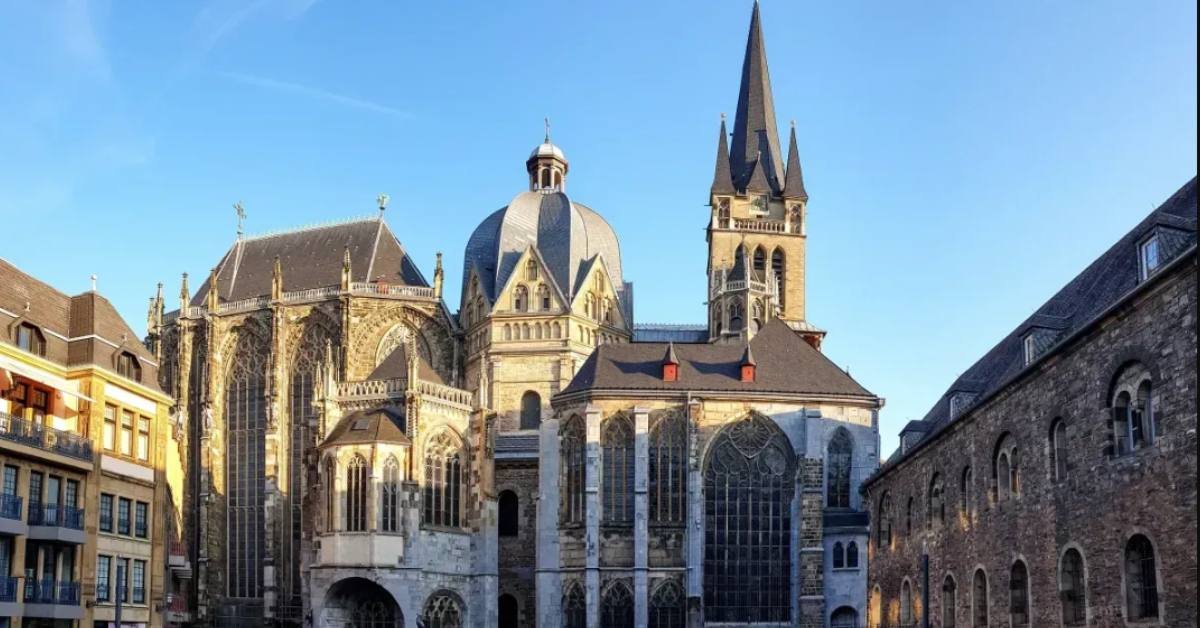Europe is a treasure trove of historical architecture, offering a journey through time with its diverse and iconic landmarks. From the majestic Gothic cathedrals like Notre-Dame in Paris to the grandeur of Renaissance masterpieces such as Florence’s Duomo, each structure tells a unique story. The Baroque splendor of St. Peter’s Basilica in Vatican City contrasts with the medieval charm of Germany’s Neuschwanstein Castle. In Spain, the intricate details of the Alhambra showcase the region’s Moorish influence, while ancient Roman engineering marvels like the Colosseum in Rome continue to awe visitors. Each of these architectural wonders provides a glimpse into the rich cultural and historical tapestry of Europe, making the continent a must-visit for history and architecture enthusiasts.
Pena Palace, Portugal
Pena Palace is one of Portugal’s most iconic landmarks, perched atop the Sintra Mountains and offering breathtaking views of the surrounding landscape. This vibrant and colorful palace is a masterpiece of 19th-century Romanticism, blending Gothic, Manueline, Moorish, and Renaissance architectural styles. Built by King Ferdinand II, the palace stands as a symbol of Portugal’s rich history and artistic heritage. Visitors to Pena Palace can explore its lavish interiors, ornate rooms, and lush gardens, all of which reflect the eclectic tastes of its creator. The palace is surrounded by the Pena Park, a sprawling forested area filled with winding paths, hidden grottoes, and exotic plants. It’s a place where nature and art come together in perfect harmony. If you’re planning a visit, securing Pena Palace tickets in advance is highly recommended, especially during the peak tourist season. Tickets can be purchased online, allowing you to skip the lines and ensure a smoother experience as you immerse yourself in the fairy-tale world of Pena Palace.
Colosseum, Italy
The Colosseum, located in the heart of Rome, Italy, is one of the most iconic symbols of ancient Roman engineering and architecture. Constructed between 70-80 AD under the emperors Vespasian and Titus, this massive amphitheater was designed to host gladiatorial contests, public spectacles, animal hunts, and even mock sea battles. With a capacity to hold up to 50,000 spectators, the Colosseum is a marvel of Roman ingenuity, featuring a complex system of vaults, arches, and corridors that facilitated the movement of large crowds. Despite suffering damage from earthquakes, stone robbers, and the passage of time, the Colosseum remains remarkably well-preserved and continues to be a major tourist attraction, symbolizing the grandeur and brutality of ancient Rome. Its significance extends beyond its architectural brilliance, serving as a reminder of the cultural and social practices of the Roman Empire. Today, the Colosseum is not only a UNESCO World Heritage Site but also a powerful monument to the history and legacy of Rome.
Royal Palace of Madrid, Spain
The Royal Palace of Madrid, or Palacio Real, is one of the most magnificent palaces in Europe and the official residence of the Spanish Royal Family, although it is now used primarily for state ceremonies. Located in the heart of Madrid, this grand Baroque palace was constructed in the 18th century and is renowned for its stunning architecture, opulent rooms, and vast art collections. Visitors to the Royal Palace can explore its many halls, including the Throne Room, the Hall of Mirrors, and the Royal Armory, each filled with priceless artifacts and exquisite decorations. The palace also boasts beautiful gardens, such as the Sabatini Gardens, which offer a peaceful retreat in the bustling city. To fully appreciate this historical gem, it’s advisable to purchase Royal Palace of Madrid tickets ahead of time. Booking tickets online ensures you can avoid long queues and make the most of your visit, whether you’re interested in the art, history, or simply the grandeur of this iconic Spanish landmark.
Neuschwanstein Castle, Germany
Neuschwanstein Castle, nestled in the Bavarian Alps of Germany, is a fairy-tale fortress that has captivated visitors with its breathtaking beauty and romantic allure. Commissioned by King Ludwig II of Bavaria in 1869, the castle was intended as a private retreat and a tribute to the operas of composer Richard Wagner, whom Ludwig greatly admired. The castle’s design, a blend of Romanesque, Gothic, and Byzantine styles, reflects the king’s fascination with medieval knights and legends, creating a dreamlike atmosphere that seems to step out of a storybook. Although Ludwig lived in the castle for only a short time before his mysterious death, Neuschwanstein has become one of the most popular tourist destinations in Europe, drawing millions of visitors each year. Its picturesque towers and turrets, set against the backdrop of rugged mountains and lush forests, have inspired countless artists and have even served as the model for Disney’s Sleeping Beauty Castle. Today, Neuschwanstein Castle stands as a symbol of romantic idealism and the whimsical vision of its creator, offering a glimpse into the fantastical world of Bavaria’s “Mad King.”
St. Basil’s Cathedral, Russia
St. Basil’s Cathedral, located in Moscow’s Red Square, is one of Russia’s most recognizable landmarks and a masterpiece of Russian architecture. Commissioned by Ivan the Terrible in the mid-16th century to commemorate his military victories, the cathedral was completed in 1561. Its most striking feature is its vibrant, multi-colored onion domes, each with a unique design, representing the flame of a bonfire reaching towards the sky. The cathedral’s design is a blend of Russian, Byzantine, and Islamic architectural styles, making it distinctively unique. Inside, the cathedral consists of nine separate chapels, each dedicated to a different saint, connected by narrow corridors and staircases. Despite its religious origins, St. Basil’s has become more of a cultural symbol than a place of worship. It has survived fires, political upheavals, and even the threat of demolition, standing resilient through centuries of Russian history. Today, it serves as a museum and a powerful symbol of Russia’s rich cultural and historical heritage, drawing visitors from around the world to marvel at its beauty and intricate craftsmanship.
Sagrada Familia, Spain
The Sagrada Familia, located in Barcelona, Spain, is an extraordinary basilica designed by the renowned architect Antoni Gaudí. Construction began in 1882 and remains ongoing, making it one of the longest-running architectural projects in history. Gaudí’s vision for the Sagrada Familia combines elements of Gothic and Art Nouveau styles, resulting in a strikingly unique and intricate structure. The basilica is renowned for its soaring towers, elaborate facades, and stunning interior, which is designed to resemble a forest of stone columns and stained glass that filters light in a mesmerizing way. Each of the three grand facades—Nativity, Passion, and Glory—tells a different aspect of the life of Jesus Christ, adorned with detailed sculptures and symbolic motifs. Despite the challenges of completing such an ambitious project, including changes in architects and construction techniques, the Sagrada Familia has become a symbol of Barcelona and an icon of modernist architecture. In 2010, it was consecrated by Pope Benedict XVI as a minor basilica. The Sagrada Familia continues to attract millions of visitors each year and is a testament to Gaudí’s innovative genius and the enduring spirit of architectural aspiration.
Palace of Versailles, France
The Palace of Versailles, located just outside Paris, France, is a monumental symbol of absolute monarchy and French opulence. Originally a hunting lodge for King Louis XIII, it was transformed by his son, Louis XIV, in the 17th century into a grandiose palace that became the center of political power in France. The palace is renowned for its stunning Baroque architecture, extensive gardens, and extravagant interiors. The Hall of Mirrors, with its 357 mirrors and gilded decor, is particularly famous, reflecting the grandeur of the French court and serving as a backdrop for many historical events. The palace’s vast gardens, designed by André Le Nôtre, feature elaborate fountains, geometric flowerbeds, and grand avenues, embodying the artistic and engineering achievements of the era. Versailles not only represents the height of royal luxury but also played a pivotal role in French history, notably serving as the site of the signing of the Treaty of Versailles in 1919, which ended World War I. Today, the Palace of Versailles is a UNESCO World Heritage Site and a major tourist attraction, admired for its historical significance and architectural splendor.
Acropolis of Athens, Greece
The Acropolis of Athens, Greece, is an ancient citadel perched on a rocky outcrop overlooking the city, and it stands as a symbol of classical Greek civilization and democracy. Dominating the Athenian skyline, the Acropolis is home to several significant structures, the most famous being the Parthenon, a temple dedicated to the goddess Athena, whom the city was named after. Constructed between 447 and 432 BC, the Parthenon exemplifies the ideals of Ancient Greek architecture with its Doric columns and intricate sculptures. Other notable buildings on the Acropolis include the Erechtheion, renowned for its Caryatids—statues of female figures serving as columns—and the Temple of Athena Nike, which commemorates military victories. The Acropolis also features the Odeon of Herodes Atticus, an ancient theater still used for performances today. As a center of artistic, political, and religious life in ancient Athens, the Acropolis has profoundly influenced Western culture and continues to be a focal point of archaeological study and cultural tourism. Recognized as a UNESCO World Heritage Site, it remains a powerful symbol of ancient Greece’s enduring legacy.
Westminster Abbey, United Kingdom
Westminster Abbey, located in the heart of London, United Kingdom, is a historic church renowned for its architectural grandeur and its role as a centerpiece of British ceremonial life. Founded in the 10th century and expanded significantly in the 13th century under King Henry III, the abbey is a stunning example of Gothic architecture, characterized by its pointed arches, ribbed vaults, and intricate stained glass windows. It has been the site of numerous royal events, including coronations, weddings, and funerals, with notable ceremonies including the coronation of William the Conqueror in 1066 and the wedding of Prince William and Catherine Middleton in 2011. The abbey is also renowned for its burial ground, which includes the graves of many significant figures in British history, such as Sir Isaac Newton, Charles Dickens, and Geoffrey Chaucer. Additionally, the Poets’ Corner is dedicated to some of the greatest writers in English literature. As a UNESCO World Heritage Site, Westminster Abbey continues to be a focal point of national identity and historical heritage, attracting millions of visitors and serving as a vibrant center for religious and cultural events.




